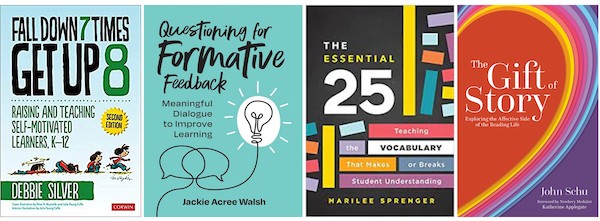Get Ready to SOAR into the New School Year!
By Kathleen Palmieri
 Where did the summer go? Here we are preparing for, or maybe already beginning, another school year. Whether you are a new or returning teacher, a new school year is exciting, but it can also be stressful.
Where did the summer go? Here we are preparing for, or maybe already beginning, another school year. Whether you are a new or returning teacher, a new school year is exciting, but it can also be stressful.
Why not SOAR into the new school year as you plan out your structure and organization, assess your classroom, review and reset? Here are a few ideas from my fifth grade classroom to get you started.
Structure
How will each day flow? First, consider the “Master Schedule” for your classes, which includes fixed specials such as music, physical education, art, and hopefully library. Block out these times in your planner.
Then include any service areas that some students may need to attend such as academic intervention, speech, or English as a new language classes. Next, create times to teach subject areas such as math, language arts, reading, social studies, and science.
Finally, consider working a “Class Meeting” into your daily schedule. This needs to be a time when all students are in the classroom. Class meetings are a great way to touch base on a social emotional level, revisit classroom behavior and expectations, and allow students time to express their thoughts and ideas. When students feel they have a voice, it is truly a game changer in the overall classroom environment.
Organization

Once you’ve gotten rid of the old, make a list of what you will need to help stay organized during the school year. Along with purchasing new baskets, bins, books, or shelving, consider what labels you may need to buy or create.
Finally, brainstorm by mapping out how you will arrange the students’ desks and any tables you have. Consider your teaching style and the flow of the room. Will you use stations? Group work? Labs? Taking the time now to think through how you will organize all aspects of your learning space will be very beneficial moving forward.
Assess
From the doorway of your classroom, take a look around and analyze what you see. Start by scanning all the walls and consider your bulletin boards. What message do they give? What purpose will they serve? Is there a flow in design, or is there too much displayed – making the room too busy?
Is there a bulletin board that seems to scream, “I’ve been hanging here for years and I look tired?” Well, if so, it’s time for a change. (By the way, it is okay to leave a blank bulletin board (or two) and allow the students to help create that space.)
Finally, look at the desk arrangement, placement of the classroom library, pencil sharpener, etc. Does the classroom feel inviting and organized, or does it feel cramped and overwhelming? I like to use the old adage, “Less is more.” If you’re feeling a bit smothered, take something out. Experiment until it feels comfy but not crowded.
Review and Reset
What icebreaker activities might you use for the first few days? How will you introduce classroom rules and expectations?
Did you use a Google Classroom? Consider how you’ve set it up and if it needs to be revamped. Will you create topics that go by the dates of each week? Will you create topics by subject area within one classroom or create multiple Google Classrooms?
Consider whether you want to create digital student portfolios for writing or to keep track of reading. Using Google Sheets to keep track of student data is a great time saver and easily accessed for meetings and conferences. If you would like to learn more about this, click on my article Use Google Sheets to Track Student Data.
It’s helpful to review your subject area curriculum maps and revisit the structure of the lessons. Look at what is expected in the first semester/quarter. Think about what went well last year or what you want to change. Consider what the objectives are for each lesson and unit, and work backward.
I also like to find some time for professional reading to help me reset and jump-start with fresh planning ideas. A few books I would highly recommend (and have reviewed) are Fall Down 7 Times Get Up 8: Raising and Teaching Self Motivated Learners by Debbie Silver; Questioning for Formative Feedback by Jackie Acree Walsh; The Essential 25: Teaching the Vocabulary That Makes or Breaks Student Understanding by Marilee Sprenger, and The Gift of Story by John Schu.
The First Few Weeks
Now that you’ve organized your classroom, it will be helpful as you pull together anything you will need for the first few weeks of subject area lessons. For example, in math and science you may need manipulatives or materials to set up a station/lab. For language arts, reading or social studies, review the readings, the writing genre, or activities and prepare for each. To help engage students, think about how you use digital resources such as Jamboard or Flippity and possibly incorporate an interactive notebook.
After you’ve prepared to soar into the new school year, it is really important to add another “R” to my acronym. Relax! Find time to enjoy with family and friends, and to do whatever makes you happy.
Feature image by Scott from Pixabay
Kathleen Palmieri is a National Board Certified Teacher and NBCT Professional Learning facilitator. She is a fifth grade educator in upstate New York who reviews and writes regularly for MiddleWeb. With a passion for literacy and learning in the classroom, she participates in various writing workshops, curriculum writing endeavors, and math presentations. As a lifelong learner, she is an avid reader and researcher of educational practices and techniques. Collaborating with colleagues and globally on Twitter @Kathie_Palmieri and expanding her education adventures at www.kathleenpalmieri.com are ongoing practices for her.





































Love your practical ideas and helpful suggestions, Kathleen! Also, thanks for the “shout out” for Fall Down 7 Times, Get Up 8! Keep your insightful articles coming!!